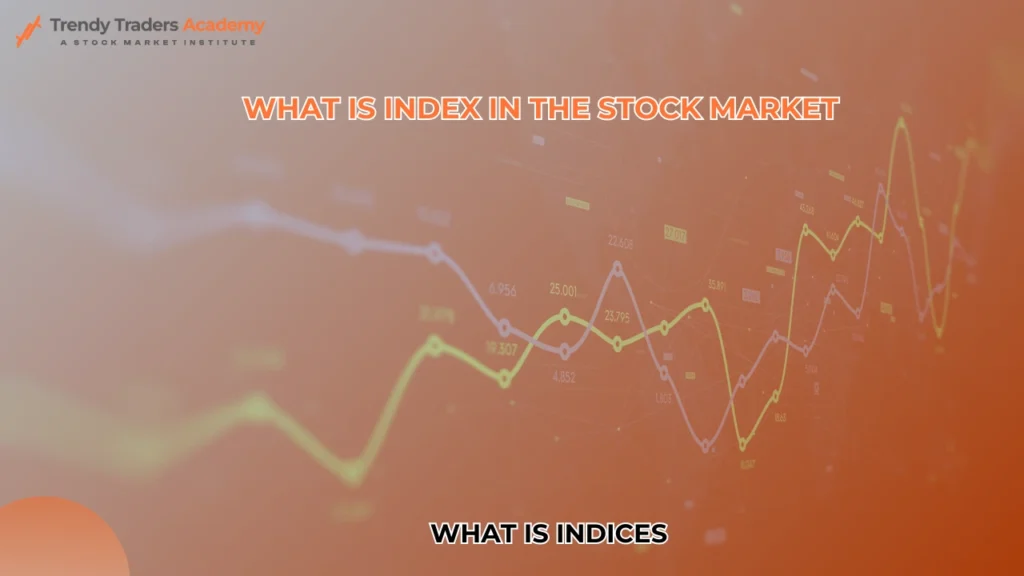
What is Index in the Stock Market / what is indices
Let us understand what is index in stock market and how many index in Indian stock market .
Stock market index is an index that measures the performance of a pool of shares believed to represent a specific market. In this regard, stock market indices in the Indian context refer to barometers that help identify the direction of a stock market to which investors can resort to when making stock trades and also as a tool for measuring performance of a specific stock or investment portfolio.
This blog will look into the details of the aspects of stock market index in India including its significance, types of index , major indices and methods for calculating them.
Purpose, Importance & What is Index in Stock Market
When you ask what is Index in stock market or how many index in Indian stock market it is Important to understand its Purpose and Importance. A stock market index serves several vital functions in the financial ecosystem:
Market Representation:
Indices of the stock market represent the performance of a given market by following a selected list of stocks that will give a reflection of a given sector in the economy. For example, the NIFTY 50 and S&P BSE SENSEX reflect market average in general.
Benchmarking:
Some known uses of indices include the investor and fund managers who compare the performance of their portfolio to a certain index in the market or in a certain segment. For example, a mutual fund that invested in the shares underlying the NIFTY 50 would judge its performance by referring to this index.
Investment Vehicles:
They are used to base financial products like Exchange Traded Funds (ETFs) and index funds which are investment products that look like an index.
Economic Indicator:
An example of a stock market index is a sign of the health of the economy or sectors of the economy. For instance, the increase in NIFTY IT visualizes development in the Indian Information technology market.
how many index in Indian stock market
Major index in Indian market
NIFTY 50 :
Being operated and owned by NSE Indices a fully owned subsidiary of the National Stock Exchange of India.
It consists of the biggest and most traded firms in the NSE with 50 firms.
Serves 13 industries that include Information Technology, Banking & Finance, Energy, power and Water, and the Pharmaceutical industries among others.
Contributes approximately 65% of the free- float market capitalization of stocks traded in the NSE.
Serves as a standard for ratings by institutional and retail investor markets.
Nifty 50 can be called as one of the stable and robust Indian stock market index .
S&P BSE SENSEX :
BSE is the entity through which it is managed.
It follows 30 leading and healthy operating companies listed on BSE.
It was developed in 1986 and therefore is one of India’s oldest indices.
This index comprises firms strictly by liquidity, total market value, and sectors of the economy they operate in.
Sensex is the Oldest and largest Indian stock market index.
NIFTY Next 50 :
Formerly known as NIFTY Junior Index, it includes top 50 shares in terms of market capitalization and tight bid offer spread but next to the NIFTY 50 companies.
Can be used as a barometer of potentially very large growth oriented large capitalization stocks.
NIFTY 500 :
Covers 500 largest companies listed on the NSE that together hold about 96.1% of the total free float market capitalization.
Gives a bird’s eye view of the stock market in India, both Large Cap, Mid Cap and Small Cap stocks are included.
Sectoral Indices :
NIFTY Bank: Centred solely on banking industry.
NIFTY IT: Focuses on big shots in the IT segment including Infosys, TCS and Wipro.
NIFTY Pharma: Acts for a variety of the largest pharmaceutical companies.
These indices enable investment on specified industries of interest.
How Stock Market Indices are Calculated ?
Stock market indices are calculated using two primary methodologies:
1. Free-Float Market Capitalization Method:
It may be mentioned that most of the Indian indices, such as NIFTY 50 and SENSEX, are based on this method.
Simply, the free float adjusts the net tangible equity by eliminating the holding of the promoter and restricted stocks.
The greater the free float market capitalization, the more impact a company has on the index.
2. Price-Weighted Method:
In this method, the index is calculated based on the stock prices of its constituents.While common in some global indices, it is less popular in India.
Formula for Free-Float Market Capitalization:
Index Value = Current Market Value of Constituents / Base Market Value X Base Index Value
Types of Stock Market index
indian stock market index can be broadly categorized as follows:
1. Broad-Based Indices:
These indices of course are indicative of the entire market or a part of it.
Examples: Nifty 50, Sensex, Nifty 500.
2. Sectoral Indices:
Target specific industries like finance, technology or power.
Example: NIFTY Bank is the index that disburses with the performance of the banking sector.
3. Thematic Indices:
Arrange the companies according to certain categories the companies can be grouped by it can be General, ESG, consumption etc.
Example: NIFTY 100 ESG Index.
4. Size-Based Indices:
This divides companies into groups by market capitalization.
Examples: Nifty Smallcap 100, Nifty Midcap 150.
5. Strategy-Based Indices:
Indexes should track investment plans like dividend yield or volatility.
Example: Nifty low volatility 50 index.
Functions of stock market indices
erformance Benchmark:
Stock indices are used by investors in getting an assessment of the portfolio performance against a certain broad market or industrial category.
Diversification:
Purchasing index funds or ETFs will put an investor in many stocks, limiting overall exposure to any one.
Informed Decision-Making:
Via index investment, people can be able to follow the emergence of trends and then invest in areas that will definitely yield them good returns.
Ease of Comparison:
It means that coordinates help in making indices with which different parts of the market can easily be compared.
Challenges and Limitations
- Limited Representation:
Not even broad-market index such as Nifty 50 or Sensitive index, SENSEX captures the whole market and only captures large-cap stocks.
- Overemphasis on Large Companies:
The free-float market capitalization method provides more emphasis on the large firms, preventing emphasis on small firms, when undertaking research.
- Market Volatility:
It is very useful to recognize that indices often move around in the short-term due to market events beyond long-term trends.
Role of indices in investment strategies
Passive Investing :
This makes investments in index funds and ETFs very helpful to investors as they do not require that the investor actively manage his portfolio.
This is beneficial since costs are reduced and the company diversify.
Sectoral Focus :
Sectoral indices afford investors an opportunity to reap out on sectors given their performance.
For example, the opportunity to invest in the NIFTY IT index can bring profit as the IT sector is developing rapidly.
Risk Management :
When investors look at indices they are able to determine the amount of risk in the market and hence be able to decide how they should invest.
Evolution of the Stock Market Indices in India
The history of stock market indices in India reflects the growth and modernization of the country’s financial markets:
SENSEX (1986):
India’s first equity index of the stock market.
When given, it offered a systematic procedure of capturing market trends.
NIFTY 50 (1996):
Shone with regards to the modern indices in India.
Specialized in tracking the performance of large capitalisation stocks.
Introduction of Sectoral and Thematic Indices:
Allowed investors to focus on certain sectors or themes of interest.
Launch of ETFs and Index Funds:
Created opportunities to save and make diversified investments.
Conclusion
Stock market indices are therefore cardinal in the study of the markets, investments, and performance appraisal. As a financial hub, India has arrays of stock indices such as, NIFTY 50, SENSEX, and sectoral indices holding a central platform for investment strategies and solidity of market health.
In particular, each of them is important for individual investors as well as for those people who manage other people’s money, for example in the fund, for the correct and successful positioning in the financial market. As it will be demonstrated, indices are useful tools that can help investors match the portfolio with prevailing trends, diversify securities, and build toward the achievement of long-term objectives.
Also Read : Top liquor stocks in india
FAQ'S
What is index in stock market ?
A stock market index is a statistical measure that reflects the performance of a group of stocks representing a specific segment of the market or the market as a whole. It helps investors track market trends and compare performance.
How does a stock market index work ?
A stock market index is calculated based on the market capitalization or price of the selected stocks in its portfolio. Changes in the prices of these stocks impact the index value.
How many stock market indices are there in the Indian stock market ?
India has several indices across the NSE and BSE, including broad market indices, sectoral indices, and thematic indices. The key ones include:
- Nifty 50
- Sensex (BSE 30)
- Nifty Next 50
- BSE Midcap
- Nifty Bank
What is the importance of a stock market index ?
Stock market indices are important for:
- Measuring market performance
- Helping investors diversify
- Serving as benchmarks for mutual funds and portfolios
- Guiding economic and market sentiment
How is a stock market index calculated ?
Indices are calculated using either the price-weighted or market capitalization-weighted method.
Formula for Free-Float Market Capitalization:
Index Value = Current Market Value of Constituents / Base Market Value X Base Index Value
For example:
Sensex: Market capitalization-weighted index
Nifty 50: Free-float market capitalization method











